Citation: Dao Viet Thang, Le Thi Mai Oanh, Nguyen Cao Khang, Nguyen Manh Hung, Do Danh Bich, Du Thi Xuan Thao, Nguyen Van Minh. Structural, magnetic and electric properties of Nd and Ni co-doped BiFeO3 materials[J]. AIMS Materials Science, 2017, 4(4): 982-990. doi: 10.3934/matersci.2017.4.982
Due to the coexistence of ferroelectric, ferromagnetic and ferroelastic orders, multiferroic materials have been attracting extremely attention of many research groups. Multiferroics exhibited potential applications in fabrication of some electronic devices such as spintronics, multi-state memories, low-field ferromagnetic sensors, and actuators [1,2]. Among the very rare natural multiferroics, bismuth iron oxide BiFeO3 (BFO), a rhombohedrally distorted perovskite, is ferroelectric below TC ~ 1103 K and antiferromagnetic below TN ~ 643 K [3,4]. The stereo-chemical activity of Bi 6s2 lone-pair electrons is responsible for non-centrosymmetric ferroelectric order along <111> direction of the cubic perovskite-like lattice [5]. However, the appearance of impurities phases in pure BFO material leads to a high leakage current, a weak ferromagnetic order, and a wide range of transition temperature [4,6]. Therefore, pure BFO material does not well respond to practical applications. In order to solve these problems, a chemical modification of doping rare-earth or transition metal ions into Bi-sites or Fe-sites in BFO crystal lattice was strongly recommended [7,8]. Many works have reported the enhancement of magnetic property, in which Bi-sites were replaced by rare-earth (RE) ions (Ho3+, La3+, Nd3+, Sm3+) or Fe-sites were replaced by transition metal (TM) ions (Ni2+, Co2+) [9,10,11]. The magneto-electric (ME) effects on these materials were assigned to the coupling between ferroelectric order resulting from electron lone pair of Bi3+ ions and the ferromagnetic (or antiferromagnetic) order resulting from the doping ions [12]. Besides, the enhancement of magnetization in BFO was also attributed to the repression of cycloid spin structure. Raghavan et al. [13] and Li et al. [14] showed that RE and TM ions co-substitution was a promising route to improve multiferroic properties due to the reduction of leakage current and the enhancement of magnetization. This can be well explained because RE substitution for the Bi-sites was considered as an effective method to decrease leakage current and enhance the magnetization while TM substitution for the Fe-sites contributed to the improvement of ferroelectric property [15,16]. Therefore, RE and TM co-doping has been expected to enhance both ferroelectric and ferromagnetic properties [17,18].
In this paper, Nd and Ni co-doped BFO was synthesized by a sol-gel method in which Ni2+-substituted concentration was kept at 2.5 mol% while Nd3+-substituted concentration varied from 0 to 15 mol%. The influence of Nd3+ and Ni2+ co-doping as well as the influence of Nd concentration on microstructure, surface morphology, ferroelectric and ferromagnetic properties were investigated to find out the optimise Nd3+ concentration for the enhancement of multiferroic property in BiFeO3 material.
Iron nitrate (Fe(NO3)3·9H2O), bismuth nitrate (Bi(NO3)3·5H2O), neodymium nitrate (Nd(NO3)3·6H2O), nickel(Ⅱ) nitrate (Ni(NO3)2·6H2O), ethylene glycol and citric acid were used for the preparation of BNFNO and BFO materials.
BNFNO and BFO powders were synthesized by a sol-gel method. Firstly, Fe(NO3)3·9H2O, Bi(NO3)3·5H2O, and Nd(NO3)3·6H2O were mixed together in a correct weight proportion. The mole of Fe(NO3)3·9H2O, Bi(NO3)3·5H2O, and Nd(NO3)3·6H2O depended on x index (x = 0.00, 0.05, 0.10, 0.125, and 0.15). The mole ratio of these chemicals was 0.975, (1 – x), and x, respectively. Afterwards, these chemicals were dissolved in 15 ml distilled water to get an aqueous solution. Then, this solution was stirred continuously at temperature 50–60 ℃ for an hour. Now, 35 ml solution of citric acid and ethylene glycol (with citric acid/ethylene glycol volume ratio 7/3) was added. After that, the last solution was evaporated at 100 ℃ for five hours to abtain wet gel. Finally, the wet gel was heated at temperature 800 ℃ for seven hours to remove organic, and get BNFNO and BFO powders.
BNFNO samples with 2.5 mol% Ni2+-substituted concentration and various Nd3+-substituted concentration were labeled according to x index in the general chemical formula of Bi1–xNdxFe0.975Ni0.025O3 (x = 0.00, 0.05, 0.10, 0.125, and 0.15).
For the investigation of ferroelectric properties, the BNFNO and BFO powders were compressed into round tablets of 6 mm in diameter under the pressure of 20 MPa. Then, tablets were sintered at 800 ℃ for 5 hours to obtain ceramic samples. Next, two sides of the tablets were polished to achieve accurate thickness of 1 mm and high smoothness. After that, Pt electrodes were coated on both sides and then heated at 500 ℃ for three hours for a good contact between Pt electrodes and ceramic tablet.
Crystal structure of BNFNO and BFO powders were characterized by different techniques. X-ray diffraction (XRD) patterns was carried out by a D5005 diffractometer using Cu-Kα radiation in 2 theta angle range of 20–65° at a step size of 0.02°. Raman scattering measurements were performed in a back scattering configuration by Jobin Yvon T64000 triple spectrometer equipped with a cryogenic change-coupled device (CCD) array detector and operated using 514.5 nm exciting beam of Ar ion laser. Surface morphology of the BNFNO and BFO powders were explored by scanning electron microscopy (SEM). Vibrating sample magnetometer (7404_VSM) was used to measure the magnetization hysteresis (M-H) loops of the BNFNO and BFO powders. The polarization electric hysteresis (P-E) loops at room temperature of sintered ceramics were measured by a ferroelectric tester (Radiant, Precision LC_10V).
The XRD patterns of BNFNO and BFO powders are shown in Figure 1a. The XRD patterns of pure BFO sample are in good accord with the powder data of JCPDS Card No. 71-2494, revealing the presence of single-phase BiFeO3 rhombohedral structure (R3C). As clearly seen, no secondary phases are found in the XRD patterns of BFO sample. For Nd and Ni co-doped BFO samples, almost all peaks of the XRD shift toward higher 2θ values which reveal a change in lattice constants. From data of the XRD, lattice constants of BNFNO and BFO samples were calculated using UnitCell software and then graphed as a function of Nd3+ concentration in Figure 1b.
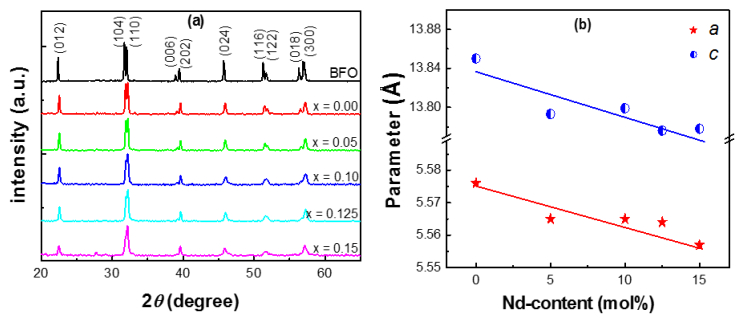 Figure 1. (a)
X-ray diffraction patterns of BFO and Bi1–xNdxFe0.975Ni0.025O3
(x = 0.00, 0.05, 0.10, 0.125, and 0.15) powders; (b) the influence of
lattice constants a and c as a function of the concentration of Nd3+.
Figure 1. (a)
X-ray diffraction patterns of BFO and Bi1–xNdxFe0.975Ni0.025O3
(x = 0.00, 0.05, 0.10, 0.125, and 0.15) powders; (b) the influence of
lattice constants a and c as a function of the concentration of Nd3+.For BFO sample, the lattice constants were determined to be a = 5.585 ± 0.001 Å and c = 13.866 ± 0.002 Å. For Nd and Ni co-doped BFO samples, it is clear that both lattice constants a and c were reduced gradually with increasing the concentration of Nd3+. This was because the radius of Nd3+ (1.109 Å) and Ni2+ (0.63 Å) ions are smaller than that of Bi3+ (1.17 Å) and Fe3+ (0.635 Å) ions, respectively. Therefore, the change of lattice constants indirectly reveals the substitution of Nd3+ and Ni2+ ions into BiFeO3 crystal lattice.
Raman scattering spectra of BNFNO and BFO powders measured at room temperature are shown in Figure 2. The previous studies have shown that Raman active modes of rhombohedral (R3C) BiFeO3can be summarized in following irreducible representation: Г = 4A1 + 9E [19,20]. In the wave number ranging from 100 to 400 cm–1, Raman scattering spectra of BFO exhibited three A1 modes at wave numbers of 132,167, and 203 cm–1 and five E modes at wave numbers of 258,275,292,318, and 355 cm–1. Since Raman scattering spectra are very sensitive to atom displacements, the change in Raman peak position with increasing Nd3+ concentrations will indicate the substitution of Nd3+ for Bi3+ and the electrical polarization. The reason is that the stereo-chemical activity of the electron lone pair of Bi plays major role in the change of Bi–O covalent bonds, and characteristic modes observed at 132,167, and 203 cm–1 for BFO sample. On the other hand, Gautam et al. [15] and Cazayous et al. [11] showed that these modes were supposedly believed to be responsible for the ferroelectric nature of the BFO sample. When Nd3+ concentration increases, there is a change in Bi–O covalent bonds as a result of the decline in the stereo-chemical activity of the electron lone pair of Bi and the long range ferroelectric order. The shift of Raman peaks towards higher wave numbers can be attributed to the change in the occupation states of Bi-site and the change in the Bi–O covalent bonds. If the vibration frequency is governed by local factors such as force constant and ion mass, it will be proportional to (k/M)1/2 where k and M are force constant and ion mass, respectively. The shift of Raman peaks at high wave numbers, the reduction in intensity of prominent modes, and even the change in crystal structure are likely due to the lattice distortion at Bi-sites due to the substitution of Nd3+ ions which have lower atom weight (144.2 g) comparing to that of Bi atom (209.0 g). Furthermore, the electron lone pair of Bi effectively reduces the k-value that is inversely proportional to the length of Bi/Nd–O bond. Thus, the shift of Raman modes toward higher frequency shows an increase of k value and an decrease of Bi/Nd–O bond length. This result shows that Bi3+-sites have been replaced by Nd3+ ions.
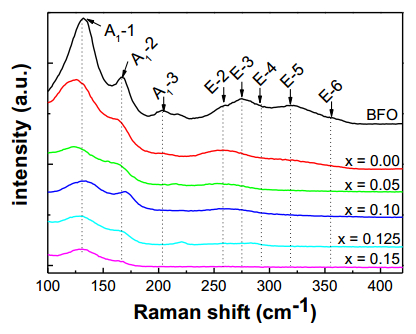 Figure 2. Raman
scattering spectra of BFO and Bi1–xNdxFe0.975Ni0.025O3
(x = 0.00, 0.05, 0.10, 0.125, and 0.15) powders.
Figure 2. Raman
scattering spectra of BFO and Bi1–xNdxFe0.975Ni0.025O3
(x = 0.00, 0.05, 0.10, 0.125, and 0.15) powders.SEM images of BNFNO (x = 0.00, 0.05, 0.10, and 0.15) powders are in Figure 3. These images show that highly dense microstructure can be obtained by increasing Nd3+ concentration in BNFNO samples. The grains exhibit in-homogenous rectangular microstructures with different sizes and shapes. It is clear that the average grain size decreases with increasing of Nd3+ concentration. This is because the decrease of surface energy (or grain boundaries energy) caused by the interaction between the grains and surface leads to the stabilization of surfaces (or boundaries). Kumarn et al. [21] showed that the main reason of the decrease of grain size was because the bond dissociation energy of Gd–O bond was stronger than that of Bi–O bond.
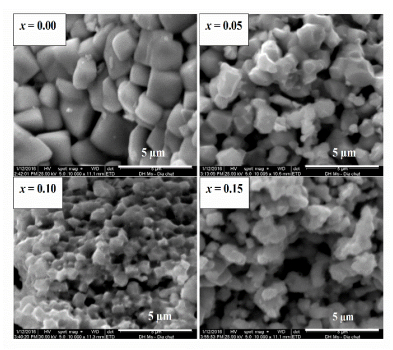 Figure 3. SEM images of Bi1–xNdxFe0.975Ni0.025O3
(x = 0.00, 0.05, 0.10, and 0.15) powders.
Figure 3. SEM images of Bi1–xNdxFe0.975Ni0.025O3
(x = 0.00, 0.05, 0.10, and 0.15) powders.The magnetization hysteresis loops of as-synthesized powders were measured by VSM at room temperature with a maximum magnetic field of 10 kOe, as shown in Figure 4a. All samples show the indication of weak ferromagnetism. The saturation magnetization (Ms) and remnant magnetization (Mr) values of BNFNO samples are graphed in Figure 4b. Ms and Mr values increase when the concentration of Nd3+ increases from x = 0.00 to x = 0.125, and then decrease with further increasing of the concentration of Nd3+ to x = 0.15. The increase of magnetism can be explained by some causes: (ⅰ) the destruction of the antiferromagnetic order due to the substitution; (ⅱ) the creation of oxygen vacancies as Ni replaced into Fe-sites; (ⅲ) the modification of the spiral spin structure caused by the decrease of Fe–O–Fe bond angles associated with the distortion of crystal structure which is due to the difference in radius of ion Nd3+ and Bi3+, leading to the decrease of Fe–O bond lengths and Fe–O–Fe bond angles as Nd3+ replaced into Bi3+-sites [22]; (ⅳ) the appearance of new magnetic interactions such as Nd3+–Nd3+, Nd3+–Fe3+, Nd3+–Ni2+, Fe3+–Ni2+, and Ni2+–Ni2+ in addition to the regular exchange interaction of Fe3+–Fe3+. Kumarn et al. [21] reported that the weak ferromagnetism behavior in Gd-doped BiFeO3 may be ascribed to partial destruction of spiral spin structure due to structural distortion and exchange interactions of Gd3+–Gd3+ and Gd3+–Fe3+.
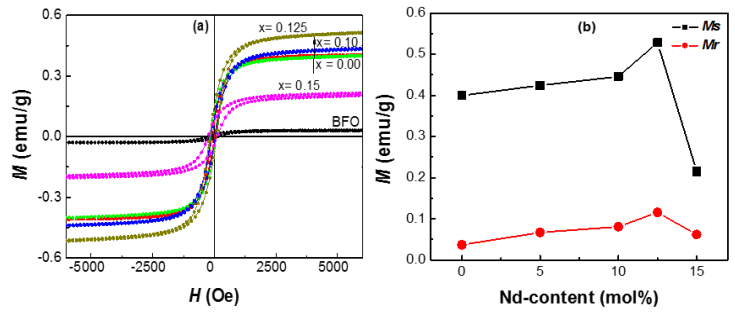 Figure 4. (a)
Magnetization hysteresis loops of BFO and Bi1–xNdxFe0.975Ni0.025O3
(x = 0.00, 0.05, 0.10, 0.125, and 0.15) powders; (b) Ms and Mr values depend on concentration of Nd3+.
Figure 4. (a)
Magnetization hysteresis loops of BFO and Bi1–xNdxFe0.975Ni0.025O3
(x = 0.00, 0.05, 0.10, 0.125, and 0.15) powders; (b) Ms and Mr values depend on concentration of Nd3+.The ferroelectric (P-E) hysteresis loops of as-synthesized sintered ceramics are shown in Figure 5a. The shape of P-E loops indicates that all samples exhibit ferroelectric behavior. When the concentration of Nd3+ increases, the shape of the P-E loops changed distinctively which reveals that Nd and Ni co-doping is effective in increasing the ferroelectric behavior of BFO. The increasing of Nd3+ concentration causes an increase in dielectric constant and decrease in leakage current as shown in Figure 5b. The main reasons can be assigned to the presence of oxygen vacancies, resulting to virtual hopping of electrons between Fe2+ and Fe3+. Rajput et al. [23] also demonstrated the increase of ferroelectric polarization as co-doping La and Ni into BFO materials. The enhanced ferroelectric properties of samples were attributed to the reduction of leakage current. Remnant polarization (Pr) and saturation polarization (Ps) increase gradually with doping concentration in which Pr values are 0.15, 2.80, 2.85, 3.39, and 9.97 µC/cm2 and Ps values are 0.33, 4.16, 7.07, 7.49, and 18.35 µC/cm2 for BNFNO (x = 0.00, 0.05, 0.10, 0.125, and 0.15) samples, respectively.
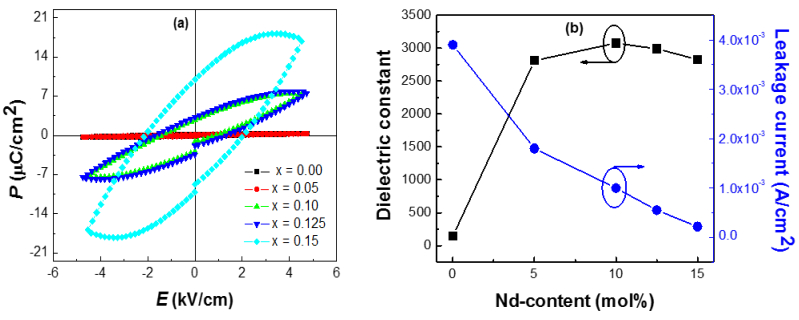 Figure 5. (a) Polarization electric hysteresis loops; (b) dielectric constant and leakage current of Bi1–xNdxFe0.975Ni0.025O3
(x = 0.00, 0.05, 0.10, 0.125, and 0.15) sintered
ceramics.
Figure 5. (a) Polarization electric hysteresis loops; (b) dielectric constant and leakage current of Bi1–xNdxFe0.975Ni0.025O3
(x = 0.00, 0.05, 0.10, 0.125, and 0.15) sintered
ceramics.In summary, the effects of Nd and Ni co-doping on the microstructure, ferroelectric and ferromagnetic properties of BFO have been investigated. The results showed the improvement of both ferroelectric and ferromagnetic properties when co-doping Nd and Ni into BiFeO3. The saturation ferroelectric polarization and remnant polarization increased from Ps = 0.33 µC/cm2 and Pr = 0.15 µC/cm2 for BNFNO with x = 0.00 up to PS = 18.35 µC/cm2 and Pr = 9.97 µC/cm2 for BNFNO with x = 0.015. The saturation magnetization Ms also increased from 0.40 emu/g for BNFNO with x = 0.00 up to 0.528 emu/g for BNFNO with x = 0.125. These results suggested that Nd and Ni co-doped BFO materials can be used for applications in multiferroic memory devices.
The authors thanks for the help of Hanoi University of Mining and Geology.
The authors declare that there is no conflict of interest.
| [1] |
Eerenstein W, Mathur ND, Scott JF (2006) Multiferroic and magnetoelectric materials. Nature 442: 759–765. doi: 10.1038/nature05023

|
| [2] |
Tokura Y (2007) Multiferroics-toward strong coupling between magnetization and polarization in a solid. J Magn Magn Mater 310: 1145–1150. doi: 10.1016/j.jmmm.2006.11.198

|
| [3] |
Qi X, Dho J, Tomov R, et al. (2005) Greatly reduced leakage current and conduction mechanism in aliovalention-doped BiFeO3. Appl Phys Lett 86: 062903. doi: 10.1063/1.1862336

|
| [4] |
Kubel F, Schmid H (1990) Structure of a ferroelectric and ferroelastic monodomain crystal of the perovskite BiFeO3. Acta Crystallogr B 46: 698–702. doi: 10.1107/S0108768190006887

|
| [5] |
Xi XJ, Wang SY, Liu WF, et al. (2014) Enhanced magnetic and conductive properties of Ba and Co co-doped BiFeO3 ceramics. J Magn Magn Mater 355: 259–264. doi: 10.1016/j.jmmm.2013.12.036

|
| [6] |
Ruette B, Zvyagin S, Pyatakov AP, et al. (2004) Magnetic-field-induced phase transition in BiFeO3 observed by high-field electron spin resonance: Cycloidal to homogeneous spin order. Phys Rev B 69: 064114. doi: 10.1103/PhysRevB.69.064114

|
| [7] |
Chakrabarti K, Das K, Sarkar B, et al. (2011) Magnetic and dielectric properties of Eu-doped BiFeO3 nanoparticles by acetic acid-assisted sol-gel method. J Appl Phys 110: 103905. doi: 10.1063/1.3662178

|
| [8] |
Lazenka VV, Ravinski AF, Makoed II, et al. (2012) Weak ferromagnetism in La-doped BiFeO3 multiferroic thin films. J Appl Phys 111: 123916. doi: 10.1063/1.4730896

|
| [9] |
Rao TD, Karthik T, Srinivas A, et al. (2012) Study of Structural, Magnetic and Electrical properties on Ho-substituted BiFeO3. Solid State Commun 152: 2071–2077. doi: 10.1016/j.ssc.2012.08.007

|
| [10] |
Xu X, Guoqiang T, Huijun R, et al. (2013) Structural, electric and multiferroic properties of Sm-doped BiFeO3 thin films prepared by the sol-gel process. Ceram Int 39: 6223–6228. doi: 10.1016/j.ceramint.2013.01.042

|
| [11] |
Cazayous M, Malka D, Lebeugle D, et al. (2007) Electric field effect on BiFeO3 single crystal investigated by Raman spectroscopy. Appl Phys Lett 91: 071910. doi: 10.1063/1.2771380

|
| [12] |
Chakrabarti K, Das K, Sarkar B, et al. (2012) Enhanced magnetic and dielectric properties of Eu and Co co-doped BiFeO3 nanoparticles. Appl Phys Lett 101: 042401. doi: 10.1063/1.4738992

|
| [13] |
Raghavan CM, Kim JW, Kim SS (2013) Structural and ferroelectric properties of chemical solution deposited (Nd, Cu) co-doped BiFeO3 thin film. Ceram Int 39: 3563–3568. doi: 10.1016/j.ceramint.2012.10.182

|
| [14] |
Li Y, Zhang H, Li Q, et al. (2012) Structural distortion and room-temperature ferromagnetization of Co-doped and (Eu, Co)-codoped BiFeO3 nanoparticles. Mater Lett 87: 117–120. doi: 10.1016/j.matlet.2012.07.043

|
| [15] |
Gautam A, Singh K, Sen K, et al. (2011) Crystal structure and magnetic property of Nd doped BiFeO3 nanocrytallites. Mater Lett 65: 591–594. doi: 10.1016/j.matlet.2010.11.002

|
| [16] |
Reddy VA, Pathak NP, Nath R (2013) Enhanced magnetoelectric coupling in transition-metal-doped BiFeO3 thin film. Solid State Commun 171: 40–45. doi: 10.1016/j.ssc.2013.07.032

|
| [17] |
Ye W, Tann G, Dong G, et al. (2015) Improved multiferroic properties in (Ho, Mn) co-doped BiFeO3 thin films prepared by chemical solution deposition. Ceram Int 41: 4668–4674. doi: 10.1016/j.ceramint.2014.12.013

|
| [18] | Coondoo I, Panwar N, Rafiq MA, et al. (2014) Structural, dielectric and impedance spectroscopy studies in (Bi0.90R0.10)Fe0.95Sc0.05O3 (R = La, Nd) ceramics. Ceram Int 40: 9895–9902. |
| [19] |
Fukumura H, Harima H, Kisoda K, et al. (2007) Raman scattering study of multiferroic BiFeO3 single crystal. J Magn Magn Mater 310: 367–369. doi: 10.1016/j.jmmm.2006.10.282

|
| [20] |
Singh MK, Jang HM, Ryu S, et al. (2006) Polarized Raman scattering of multiferroic BiFeO3 epitaxial films with rhombohedral R3c symmetry. Appl Phys Lett 88: 042907. doi: 10.1063/1.2168038

|
| [21] |
Kumarn M, Sati PC, Chhoker S, et al. (2015) Electron spin resonance studies and improved magnetic properties of Gd substituted BiFeO3 ceramics. Ceram Int 41: 777–786. doi: 10.1016/j.ceramint.2014.09.002

|
| [22] |
Suresh P, Srinath S (2014) Study of structure and magnetic properties of rare earth doped BiFeO3. Physica B 448: 281–284. doi: 10.1016/j.physb.2014.03.040

|
| [23] |
Rajput SS, Katoch R, Sahoo KK, et al. (2015) Enhanced electrical insulation and ferroelectricity in La and Ni co-doped BiFeO3 thin film. J Alloy Compd 621: 339–344. doi: 10.1016/j.jallcom.2014.09.161

|
| 1. | Soumya G. Nair, Jyotirmayee Satapathy, N. Pavan Kumar, Influence of synthesis, dopants, and structure on electrical properties of bismuth ferrite (BiFeO3), 2020, 126, 0947-8396, 10.1007/s00339-020-04027-x | |
| 2. | Dao Viet Thang, Nguyen Manh Hung, Nguyen Cao Khang, Le Thi Mai Oanh, Structural and multiferroic properties of (Sm, Mn) co-doped BiFeO3 materials, 2020, 7, 2372-0484, 160, 10.3934/matersci.2020.2.160 | |
| 3. | A.T. Apostolov, I.N. Apostolova, J.M. Wesselinowa, Magnetic field effect on the dielectric properties of rare earth doped multiferroic BiFeO3, 2020, 513, 03048853, 167101, 10.1016/j.jmmm.2020.167101 | |
| 4. | S. R. Dhanya, Jyotirmayee Satapathy, Pavan Kumar, A review on the structural and magnetic properties of differently doped bismuth-ferrite multiferroics, 2021, 27, 0889-311X, 178, 10.1080/0889311X.2021.2020262 | |
| 5. | Mekonnen Tefera Kebede, Sheela Devi, Babita Tripathi, Sunil Chauhan, Venus Dillu, Structural transition and enhanced magnetic, optical and photocatalytic properties of novel Ce–Ni co-doped BiFeO3 nanoparticles, 2022, 152, 13698001, 107086, 10.1016/j.mssp.2022.107086 | |
| 6. | Dao Viet Thang, Nguyen Manh Hung, Du Thi Xuan Thao, Le Thi Mai Oanh, Do Danh Bich, Nguyen Cao Khang, Van Quang Nguyen, Nguyen Van Minh, Structural, Electrical, and Magnetic Properties of Bi0.90Nd0.10Fe0.98TM0.02O3 (TM=Mn, Co, Ni, and Cu) Materials, 2019, 10, 1949-307X, 1, 10.1109/LMAG.2019.2896847 | |
| 7. | Ibtissem Ragbaoui, Samia Aydi, Souad Chkoundali, Marwa Enneffati, Abdelhedi Aydi, Effect of substitution on the structural, electrical properties, and dielectric relaxor behavior in lead-free BiFeO3-based ceramics, 2024, 14, 2046-2069, 1330, 10.1039/D3RA06962A |